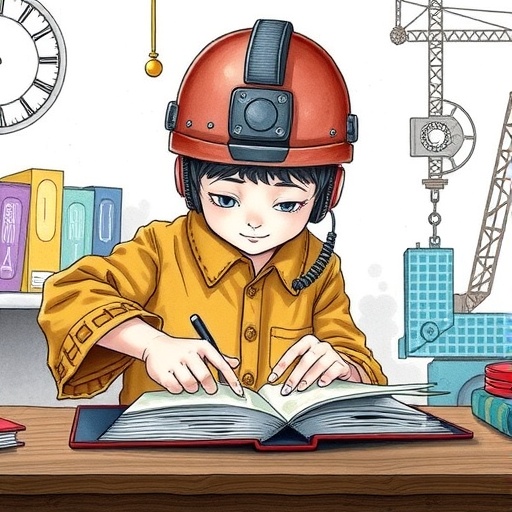In an increasingly technology-driven world, the way children are introduced to the principles of engineering is becoming increasingly critical. A recent study titled “Representation in Engineering-Focused Children’s Literature: A Critical Content Analysis” by Eckhoff delves into the portrayal of engineering concepts within children’s literature. This investigation isn’t just a cursory glance at a few popular titles; rather, it provides a deep dive into how these narratives can shape children’s perceptions of engineering as a discipline. With the backdrop of societal shifts towards STEM fields—science, technology, engineering, and mathematics—this analysis stands as a beacon for educators, parents, and writers alike.
At its core, Eckhoff’s research emphasizes the importance of representation in engineering-focused stories. Representation matters significantly in shaping the aspirations of young readers, particularly underrepresented groups in STEM. The analysis scrutinizes various texts targeted at children aged between five and twelve, aiming to uncover how effectively these stories encourage an interest in engineering. This age range is critical because early exposure can lead to long-lasting impacts on children’s career aspirations and self-perceptions in technical fields.
One of the intriguing discoveries from this research is how children’s literature often simplifies complex engineering concepts to make them digestible for young readers. While this simplification can serve a pedagogical purpose, it raises questions about whether the narratives provide a realistic portrayal of engineering challenges. The study examines a range of texts, from picture books to chapter books, noting that while some successfully present engineering in an engaging manner, others fall short by either over-simplifying or misrepresenting core concepts.
Eckhoff identifies a troubling trend: many engineering-themed children’s books do not adequately showcase diversity in character representation. A disproportionate number of protagonists are depicted as white males, which can inadvertently deter young girls and children of color from envisioning themselves in engineering roles. This lack of diversity in representation is particularly concerning as it reinforces stereotypes about who can be an engineer. As educational institutions strive for inclusivity, it becomes imperative that children’s literature reflects this ethos.
The analysis also highlights language as a crucial element in literary representations of engineering. Many books use jargon or technical terms that, while accurate, may alienate young readers. If children encounter overwhelming language without adequate explanation, they could be discouraged from pursuing engineering interests. Interestingly, the study suggests that stories which weave in engineering concepts with relatable narratives are more successful in keeping children engaged while also educating them about the field.
Another vital aspect investigated in the study is the absence of real-world applications of engineering principles in many children’s books. While some stories introduce basic concepts, they often fail to connect these ideas to everyday experiences. This disconnect can lead to a gap in understanding how engineering impacts our daily lives. Bringing in real-world applications could enhance interest and demonstrate the tangible outcomes of engineering practices—something that could inspire future generations to engage with this vital field.
Furthermore, the research discusses the role of illustrations in children’s literature. Pictures serve as powerful tools to capture interest and convey complex ideas. In examining the artworks accompanying engineering narratives, Eckhoff found that a well-executed illustration can enhance comprehension and emotional engagement significantly. However, there were notable inconsistencies in how effectively illustrations complemented the text, leading to a lack of cohesiveness in some works.
The findings suggest that to nurture interest in engineering, children’s literature must evolve. Authors and illustrators are encouraged to work collaboratively with educators and engineers to create stories that accurately reflect engineering principles while remaining accessible to children. This collaborative approach could yield new narratives that not only inform but also inspire a wider audience.
Eckhoff’s critical content analysis serves as a clarion call for stakeholders in children’s literature to prioritize representation and realism. It underscores the role that thoughtful storytelling can play in shaping the perceptions of future engineers. The recommendations outlined in this study offer practical guidance for authors aiming to create impactful engineering-focused literature that caters to diverse audiences.
Moreover, the study draws attention to the need for support from the publishing industry. Publishers play a pivotal role in deciding which stories reach classrooms and homes. By championing diverse and accurately representative narratives, publishers can help shift the conversation around who can become an engineer and what engineering looks like. The ultimate goal is to create a pipeline of interest and engagement in engineering that reflects the diversity of our society.
Engaging children with engineering concepts through literature not only cultivates knowledge but also encourages critical thinking and problem-solving skills. This study suggests that within the pages of a book lies the potential to ignite curiosity and should be harnessed effectively. In a world where engineering drives innovation, it is essential that all children feel empowered to imagine themselves as contributing members of this field.
In summary, Eckhoff’s research provides insightful perspectives on the connections between children’s literature and engineering education. It advocates for a thoughtful approach to writing, one that values diversity, accessibility, and accuracy. By recognizing the power of narratives and their ability to shape young minds, stakeholders can work together to inspire the next generation of engineers.
As children’s literature continues to evolve, attention must be given to how these stories impact young readers. By fostering inclusivity and realistic portrayals of engineering, society can empower all children to pursue careers in STEM fields, ultimately benefiting both the individual and the industry at large.
Subject of Research: Representation in Engineering-Focused Children’s Literature
Article Title: Representation in Engineering-Focused Children’s Literature: A Critical Content Analysis
Article References: Eckhoff, A. Representation in Engineering-Focused Children’s Literature: A Critical Content Analysis. IJEC 57, 527–545 (2025). https://doi.org/10.1007/s13158-024-00409-x
Image Credits: AI Generated
DOI:
Keywords: Engineering representation, children’s literature, STEM education, diversity in literature, narrative analysis, critical content analysis.




